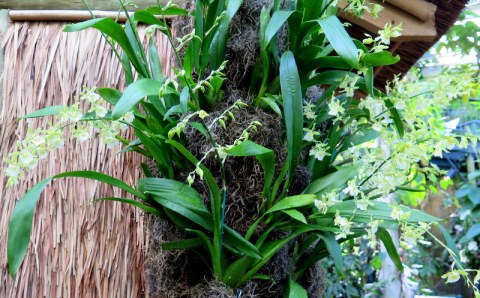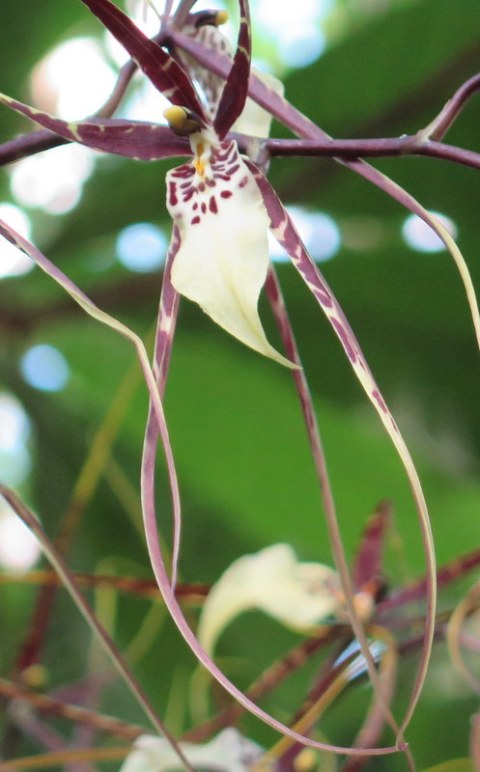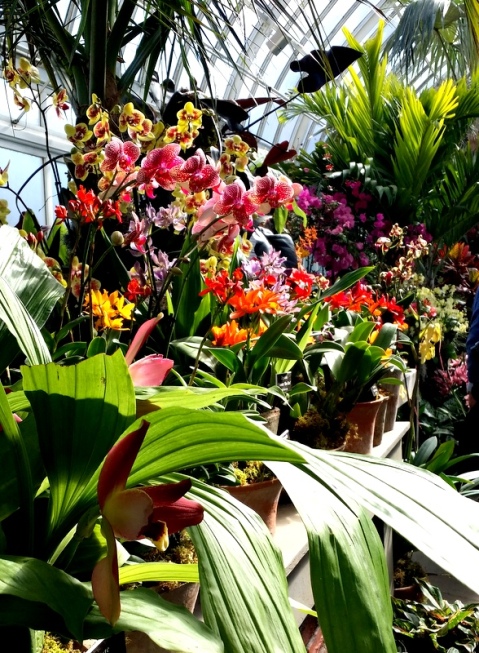NYBG Orchidelirium: The Victorians’ Obessession for Orchids and Profits

Phalaenopsis at NYBG Orchidelirium Photo by Carole Di Tosti
Phalaenopsis orchids, the most ubiquitous of flowers, hardly garner a second glance when we stroll by the myriad colored hybrids that adorn restaurants, homes, offices, and flower sections of grocery stores.

Opsistylis Mem. Mary Nattrass NYBG Orchidelirium Photo by Carole Di Tosti
However, in 19th century Victorian England, if you had orchids in your parlour, you were most probably a member of the upper class. Orchids were a costly rarity, and for much of the 19th century, these plant gems remained in the domain of aristocrats, whose adoration of spectacular orchid originals epitomized the genteel display of power, status, and luxury.

Phalaenopsis I-Hsin Sun Beauty at NYBG Orchidelirium Photo by Carole Di Tosti
In celebration of those passionate Victorians whose obsessions spawned perilous journeys and whose collectors’ cultivations helped to transform the field of plant research, propagation, and conservation, this year’s theme of the NYBG Orchid Show, is “Orchidelirium.” Representative of all that is exceptional and dynamic about this monumental flowering plant family Orchidaceae (over 30,000 naturally occurring species from tiny to large, with over 150,000 man-made hybrids), NYBG “Orchidelirium” in its intense visual design and intriguing tour layout circumscribes the trending mania that burst onto the scene in Victorian England. The exhibition highlights the finest and most innovative creative impulses of the time and recalls some of the most nefarious of human activity before profiteering, exploitation, and habitat destruction became the anathema they are today.
Marc Hachadourian (NYBG orchid curator) holding the beloved Psychopsis papilio that whetted the Duke of Devonshire’s obsession for more rare beauties. Photo: Carole Di Tosti
The euphoria began when the Duke of Devonshire fixated upon a dazzling, most singular orchid, Psychopsis papilio. Enchanted, he lusted for more “living jewels” and commissioned explorers to travel the continents and bring back obscure treasures. They did. His addiction grew. Word spread. London’s upper class’ fanaticism was set ablaze, and the orchid craze catapulted into hyper-drive.

Close up of the Psychopsis papilio that started orchid mania and determined the British Duke of Devonshire to amass the largest private orchid collection in the world at his Chatsworth House estate in Derbyshire which you can visit today. Photo Carole Di Tosti
The Duke’s head gardener Joseph Paxton revolutionized greenhouse design and orchid cultivation for the Duke whose expanding collection (eventually his greenhouses were over an acre under glass), inspired his wealthy friends to also display their unrivaled orchid prizes. Soon hundreds of adventurers were commissioned to travel on the high seas and bring back all the obscure, unparalleled beauties they could find. In 10 years the Duke possessed the largest private orchid collection in the world centered at his Chatsworth House estate. The grandiloquent gardens, greenhouses, and impressive buildings in Derbyshire, which recall the wealth and splendiferous grounds of Mr. Darcy’s estate in Pride and Prejudice, are worth the visit if you are traveling to the UK.
 Fragrant Dancing Ladies Orchid, Oncidium, Rosy Sunset ‘F’ NYBG Orchidelirium. The oncidium orchids carry a lovely fragrance of roses or chocolate. Photo: Carole Di Tosti
Fragrant Dancing Ladies Orchid, Oncidium, Rosy Sunset ‘F’ NYBG Orchidelirium. The oncidium orchids carry a lovely fragrance of roses or chocolate. Photo: Carole Di Tosti

Miltoniopsis Herralexandre (pansy orchid) NYBG Orchidelirium Photo:Carole Di Tosti
Our love of orchids has been tempered with an ethical imperative about conservation and preservation of habitats that was absent back in the time of the exploitative, predatory Victorians. Throughout, this prodigious show highlights the extent of the Victorians’ often piratical obsession, not only through its exquisite, floral pageantry but by showcasing the historical artifacts, books, pictures, narratives that adorn the pathways where the lusciously fragrant Oncidium Rosy Sunset ‘F’ orchids dance (they smell like chocolate), and the Miltoniopsis Herralexandre (pansy orchids) charm with their smiling faces that bloom with scintillating color. The narrative discloses “movers and shakers like Benedikt Roezl, the “Prince of Orchid Hunters,” who was the most famous and successful orchid collector of the era.

Featured display introducing Orchidelirium in the Palms of the World Gallery and Reflecting Pool. Photo by Carole Di Tosti
The exhibition is breathtaking in its conceptualization, scope, design, and presentation. It is partly conceived as an expeditionary journey that snakes through the greenhouse galleries and suggests the diversified habitats that recall the various continents spanning rain forests, mountains, and deserts (orchids live in all continents with the exception of Antarctica), where orchids luxuriate. One first enters the conservatory’s Palms of the World Gallery Reflecting Pool and is struck by the explosion of whites, fuscias, variegated roses, pinks, and maroons of reigning Phalaenopsis which cascade dripping Spanish moss from elevated dispositions in the trees. The featured display symbolizes how far orchid cultivation has come from hunters poaching species in the wild to the massive hybridization and cultivation of Orchidaceae it is today.

Oncidium Irish Mist ‘Big Hot Sun’ Photo by Carole Di Tosti

Bratonia Kaui’s Choice-note the long petals. NYBG Orchidelirium Photo by Carole Di Tosti

Vanilla orchid not in bloom, pods visible. Photo by Carole Di Tosti
Around each turn is the unusual, like the vanilla orchid whose pods are not beans and which is the only orchid of natural economic value from which we derive all our vanilla flavoring. According to Marc Hachadourian who walked with us along the orchid trail, the vanilla seed pod of the orchid is what is taken, dried and cured and as a result of that curing process or fermentation, that’s where natural vanilla comes from. So the Madagascar and Tahitian vanilla which is the real vanilla extract, comes from the seed pod of an orchid. Marc referred to the black flecs in Vanilla Haagen dazs ice cream which are from the vanilla orchid seed pod. “You see, you’ve been eating orchids your entire life and didn’t know it.”
As we move along the trail, Marc informs us of the tremendous diversity of orchids which are highly adaptable to all terrains and climates and are the reason why researchers use them in their plant studies. Along the pathway through the galleries that mimic the various terrains where orchids grow, you will encounter the desert orchid Eulophia Petersii.

Photo of desert orchid in bloom in the NYBG desert gallery. Photo of photo by Carole Di Tosti
 The Desert Orchid Eulophia Pettrsii has adapted to the terrain in that has stems like the swollen stems of a cactus and it has a defense; the edges of the leaves which are like a saw, may cut you. Orchids adapt to every location in the world but Antarctica.
The Desert Orchid Eulophia Pettrsii has adapted to the terrain in that has stems like the swollen stems of a cactus and it has a defense; the edges of the leaves which are like a saw, may cut you. Orchids adapt to every location in the world but Antarctica.
There is also a display case filled with orchid miniatures and valuable, rare orchids from the NYBG’s permanent collection. Within the case is a yellow orchid from Southeast Asia that has the fragrance of horse manure, a scent irresistible to its fly pollinators. As he walked with us Marc Hachadourian discussed that he even had equestrians test it and verify the scent. According to Marc, “It’s one of the things that orchids are known for, the really bizarre pollination biology sort of verging on science and science fiction.

The Bulbophyllum orchid smells like horse manure fragrant to its fly pollinators. This may be found in the permanent orchid collection ,NYBG Orchidelirium. Photo by Carole Di Tosti
The winding trails of the rainforest gallery recall the thick jungles of an earlier time when thousands of undiscovered orchid species proliferated with abandon. Their abundance was staggering. It exists no longer, having fallen prey to wasteful plunderers. Stop to read the story synopses of collectors and nurserymen and see how the orchid hunters lived while under threat of tropical diseases (malaria, yellow fever, blackwater fever), big jungle cats, and other predatory animals. Historically recorded are some of the most dastardly examples of plant exploitation, cupidity, and habitat destruction, encouraged by the likes of self-proclaimed “Orchid King” Henry Frederick Conrad Sander.

On the orchid trail with Marc Hachadourian who points out the typical shelter of an orchid hunter at NYBG Orchidelirium. Photo by Carole Di Tosti
Sander sent out twenty explorers at a time to South and Central America, India, Burma, etc., all in the name of possessing, monopolizing, propagating, and monetizing the most inimitable specimens. The collector amassed a fortune, grew between 1 and 2 million orchid plants in his nurseries, and was named Royal Orchid Grower to Queen Victoria. The NYBG bought orchids from Sander. One of them, a Vandopsis gigantea purchased in 1904 and on display, is almost as old as the NYBG which is celebrating its 125th Anniversary this year. The Vandopsis gigantea is in its 112th year.
Behind the scenes of the splendid faerie blooms imperiously showcased in sedate upper class English parlours and Joseph Paxton designed conservatories (his greenhouse innovations influenced the Enid A. Haupt Conservatory design), lurked venality, bellicosity and coldblooded aggression. The orchid wilds were foreboding territories of mayhem and murder. Avaricious collectors like Sander and his competitors (Dr. John Lowe, Beechers, Veitch & Sons), hired ruthless, cutthroats to seek and discover peerless finds that would yield a veritable king’s ransom ($100,000 and more in today’s currency for a single orchid). If they could destroy their rivals’ orchid specimens, urinate on them, burn down forest habitats, cut down trees (4000 were cut during an expedition), throw competitors “off the scent” of a particularly stupendous find by slyly redirecting them, and generally assure their orchid bosses’ exclusivity in nature’s masterpieces, they succeeded. That was the “game of orchids.”

The interior of the hut with the implements the orchid hunter used including the Wardian Case found on the orchid trail NYBG Orchidelirium. Photo by Carole Di Tosti
Along the garden tour is placed an orchid hunter’s grass hut. Inside, along with examples of his tools and implements, is his Wardian Case (an early terrarium), where he would create a kind of micro-climate for his orchids’ preservation on the long journey home. Wardian Cases were also used to display orchids. A few in this exhibition display delicate orchid miniatures.

Photo of a sketch/photo of Benedikt Roezl, “Prince of Orchid Hunters,” an intrepid gardener, horticulturalist and orchid collector who discovered 800 different species of orchids. NYBG Orchidelirium Photo by Carole Di Tosti
The life of the orchid explorer was arduous and death-defying at every turn. One can review chronicles of those who drowned in the Orinoco (William Arnold), were attacked or mauled by jaguars and tigers, were felled by dysentery (Gustav Wallis), or yellow fever (Frantisek Klaboch), or robbed 17 times at gun or knifepoint (Benedikt Roezl). There were many who simply didn’t return. (David Burke, a Veitch hunter was murdered as many probably were). Indeed, though these brazen, plunderers might fiercely fight with spear, gun or knife, they were duty bound to come back alive with their “booty.” If they killed a rival or indigenous peoples to preserve their stash? Well…
Susan Orlean’s John Larouche of The Orchid Thief and the posse of Seminoles who were arrested in 1994 for poaching the ghost orchid from Fakahatchee Strand State Preserve are pussy cats in comparison to the wanton, fortune hunting Victorians. They were not constrained by any laws except the laws of the jungle, where only the fittest survived to plunder the precious rarities that had never been discovered before.

Rare orchid in the glass display case as part of the permanent collection. NYBG Orchidelirium Photo by Carole Di Tosti
Is it any wonder that Charles Darwin, Victorian contemporary and “fantastic observational botanist” (quote from Marc Hachadourian NYBG orchid curator), who was all too familiar with the rapacious frenzy of orchid collectors and the lurid stories of explorers’ dire misfortunes in jungles, high plains, mountains, and plateaus, that the notion of predatory survival in nature spoke to his heart and perhaps added weight to his evolutionary theories?There is a nod to Darwin as an aficionado of orchids with a marvelous explanation and illustrations of an ingenious discovery Darwin intuited about the Darwin Star Orchid and its pollinator that you can see on your way through the galleries.

Paphiopedilum (lady slippers) and Nepenthes (pitcher plants) in a gallery before the final exhibition centerpiece. NYBG Orchidelirium Photo: Carole Di Tosti
In the gallery just before reaching the finale you will find an interesting display of the unusual that Christian Primeau (see previous articles on this site) designer of Orchidelirium really enjoy: Paphiopedilum and Nepenthes which also can be found in the centerpiece where they are quietly tucked in and create uniqueness and an innovative touch to the usual gorgeous and brilliant displays.

A view of the orchid mountain from the previous gallery. NYBG Orchidelirium Photo by Carole Di Tosti
On the final expeditionary leg one reaches the centerpiece of the exhibition, and the apotheosis of Victorian orchid frenzy, a 360 degree supernal, floral prominence rising over 8 feet tall in glittering, vivid technicolor. This otherwordly mountain is awash with orchids of varying species, Phalaenopsis, Oncidopsis, Oncostele, Oncidium, Vandas, Paphiopedilum (lady slippers). The hundreds of orchids vibrate a multitude of colors-fuscias, yellows, variegated pinks, roses, tricolors, whites, pale yellows, maroons, and more.

Another view of the orchid mountain with waterfall at the far side NYBG Orchidelirium Photo: Carole Di Tosti

Another view of the mountain NYBG Orchidelirium Photo: Carole Di Tosti

A studied vignette of the mountain with Bromeliads and Phalaenopsis NYBG Orchidelirium. Photo by Carole Di Tosti
This mountain created with volcanic rock, steel cubes, and chicken wire with a secret door to water the plants from the inside is “an homage” (Primeau’s words), to those who have gone before…to the avid collectors who endured the wrath of indigenous peoples, poisonous serpents, insects the size of birds, predatory animals, and murderous rivals in their exploits to scour unknown terrain, even lava-spewing volcanoes (Roezl did this), for the most exquisite and valuable of Orchidaceae. Despite the negatives, we have the Victorians to thank for their remarkable finds and innovations in cultivation and propagation.

Illustration of a potting bench with a variety of orchids one might find in an orchid collector’s greenhouse. NYBG Orchidelirium Photo: Carole Di Tosti
Victorian Orchidelirium gave birth to the billion dollar orchid industry that abides today. It even gave rise to the New York Botanical Garden’s ornate Victorian Enid A. Haupt Conservatory and its missions of research, preservation and protection of orchid species and hundreds of other plants that are becoming extinct because of illegal poaching, habitat destruction and climate change. With every delicate bloom, every fern, every pitcher plant, “Orchidelirium” is a bedazzling, live horticultural spectacular, a sterling exhibition to celebrate the NYBG’s 125 Anniversary.
The NYBG Orchid Show 2016 concludes April 17th. Check the Garden website for details about Orchid Evenings on Saturdays (March 12, 19, 26, April 2, 9, 16), as well as Friday (April 15), and Thursday (March 24, LGBT night). On select evenings visitors can also upgrade to V.I.P. status and enjoy an Orchid Lounge.
A shorter version of this article appeared on Blogcritics.
Posted on March 9, 2016, in cd, NYBG EXHIBITS and tagged Christian Primeau, Marc Hachadourian, NYBG, Orchidelirium, orchids, Victorian orchid delirium, Victorians. Bookmark the permalink. Leave a comment.
Leave a comment
Comments 0